Renewable Electricity Generation in Small Island Developing States: The Effect of Importing Ammonia
Abstract
:1. Introduction
2. Methodology
3. Results
3.1. Curaçao
3.2. Fiji-Viti Levu
3.3. Sensitivity Analysis
Effect of Ammonia Price
4. Discussion
- Plant size. GW-scale green ammonia plants have been announced [56]. Furthermore, partial decarbonization of existing renewable ammonia plants decrease the cost of renewable ammonia.
- Lower cost of electricity generation. The electricity cost of complementary offshore wind and solar PV is below 0.02 USD/kWh in some locations [57]. Levelized cost of onshore wind 0.05 USD/kWh on Curaçao and 0.46 USD/kWh on Viti Levu were found in this work.
- Higher load factor. Upon combining wind and solar PV, ammonia production with electrolyzer load factors up to 60–70% may be achieved [58,59]; decreasing the cost of the ammonia production plant. For reference, the onshore wind-based ammonia plant only operates at a load factor of 41% for Curaçao and 20% for Viti Levu. Thus, local production could become more attractive by increasing the utilization factor of the AEHB system.
5. Conclusions
Supplementary Materials
Author Contributions
Funding
Institutional Review Board Statement
Informed Consent Statement
Data Availability Statement
Conflicts of Interest
References
- Ornes, S. How does climate change influence extreme weather? Impact attribution research seeks answers. Proc. Natl. Acad. Sci. USA 2018, 115, 8232–8235. [Google Scholar] [CrossRef] [PubMed] [Green Version]
- United Nations. 2014 Samoa Pathway: UN Resolution SAMOA Pathway. Population English Edition. Available online: https://sustainabledevelopment.un.org/samoapathway.html (accessed on 28 March 2022).
- Biggs, E.M.; Bruce, E.; Boruff, B.; Duncan, J.M.; Horsley, J.; Pauli, N.; McNeill, K.; Neef, A.; Van Ogtrop, F.; Curnow, J.; et al. Sustainable development and the water–energy–food nexus: A perspective on livelihoods. Environ. Sci. Policy 2015, 54, 389–397. [Google Scholar] [CrossRef] [Green Version]
- van der Velde, M.; Green, S.; Vanclooster, M.; Clothier, B. Sustainable development in small island developing states: Agricultural intensification, economic development, and freshwater resources management on the coral atoll of Tongatapu. Ecol. Econ. 2007, 61, 456–468. [Google Scholar] [CrossRef]
- Connell, J. COVID-19 and tourism in Pacific SIDS: Lessons from Fiji, Vanuatu and Samoa? Round Table 2021, 110, 149–158. [Google Scholar] [CrossRef]
- To, L.S.; Bruce, A.; Munro, P.; Santagata, E.; MacGill, I.; Rawali, M.; Raturi, A. A research and innovation agenda for energy resilience in Pacific Island Countries and Territories. Nat. Energy 2021, 6, 1098–1103. [Google Scholar] [CrossRef]
- Sagel, V.N.; Rouwenhorst, K.H.; Faria, J.A. Green ammonia enables sustainable energy production in small island developing states: A case study on the island of Curaçao. Renew. Sustain. Energy Rev. 2022, 161, 112381. [Google Scholar] [CrossRef]
- ISPT. Power to Ammonia. Report, 51. Available online: https://www.topsectorenergie.nl/sites/default/files/uploads/Energie en Industrie/Power to Ammonia 2017.pdf (accessed on 22 April 2022).
- Rouwenhorst, K.H.; Van der Ham, A.G.; Mul, G.; Kersten, S.R. Islanded ammonia power systems: Technology review & conceptual process design. Renew. Sustain. Energy Rev. 2019, 114, 109339. [Google Scholar] [CrossRef]
- Bañares-Alcántara, R.; Dericks, I.I.I.; Fiaschetti, M.; Grünewald, P.; Lopez, J.M.; Tsang, E.; Yang, A.; Ye, L.; Zhao, S. Analysis of Islanded Ammonia-based Energy Storage Systems, (October), 1–150. 2015. Available online: https://dokumen.tips/download/link/analysis-of-islanded-ammonia-based-energy-storage-of-islanded-ammonia-based (accessed on 22 April 2022).
- Nayak-Luke, R.M.; Bañares-Alcántara, R. Techno-economic viability of islanded green ammonia as a carbon-free energy vector and as a substitute for conventional production. Energy Environ. Sci. 2020, 13, 2957–2966. [Google Scholar] [CrossRef]
- Salmon, N.; Bañares-Alcántara, R.; Nayak-Luke, R. Optimization of green ammonia distribution systems for intercontinental energy transport. iScience 2021, 24, 102903. [Google Scholar] [CrossRef]
- Salmon, N.; Bañares-Alcántara, R. Green ammonia as a spatial energy vector: A review. Sustain. Energy Fuels 2021, 5, 2814–2839. [Google Scholar] [CrossRef]
- Dias, V.; Pochet, M.; Contino, F.; Jeanmart, H. Energy and Economic Costs of Chemical Storage. Front. Mech. Eng. 2020, 6, 1–17. [Google Scholar] [CrossRef]
- Muñoz Sabater, J. ERA5-Land hourly data from 1950 to 1980. Copernicus Climate Change Service (C3S) (2017): ERA5: Fifth Generation of ECMWF Atmospheric Reanalyses of the Global Climate. Copernicus Climate Change Service Climate Data Store (CDS). 2021. Available online: https://cds.climate.copernicus.eu/cdsapp#!/datashomet/reanalysis-era5-land?tab=overview (accessed on 21 December 2021).
- Ministry of Energy and Energy Industries|Ammonia. Available online: https://www.energy.gov.tt/our-business/lng-petrochemicals/petrochemicals/ammonia/ (accessed on 12 April 2022).
- Brazil Ammonia Production by Year (Thousand Metric Tons of Contained Nitrogen). Available online: https://www.indexmundi.com/minerals/?country=br&product=ammonia&graph=production (accessed on 12 April 2022).
- Australia—Ammonia Energy Association. Available online: https://www.ammoniaenergy.org/regions/australia/ (accessed on 12 April 2022).
- Million Tonnes Per Year Renewable Ammonia in Chile—Ammonia Energy Association. Available online: https://www.ammoniaenergy.org/articles/4-4-million-tonnes-per-year-renewable-ammonia-in-chile/ (accessed on 12 April 2022).
- Curaçao Ports Authority Curaçao Ports Authority. 2022. Available online: http://curports.com/ (accessed on 6 February 2022).
- Sea Ports of Fiji FJ. 2022. Available online: https://www.searates.com/maritime/fiji (accessed on 6 February 2022).
- IRENA. Energy Profile Fiji. 2021. Available online: https://www.irena.org/IRENADocuments/Statistical_Profiles/Oceania/Fiji_Oceania_RE_SP.pdf (accessed on 22 April 2022).
- Renewable Energy Statistics. 2021. Available online: https://irena.org/publications/2021/Aug/Renewable-energy-statistics-2021 (accessed on 27 March 2022).
- IRENA. Fiji Renewables Readiness Assessment. 2015. Available online: https://www.irena.org/-/media/Files/IRENA/Agency/Publication/2015/IRENA_RRA_Fiji_2015.pdf (accessed on 22 April 2022).
- Renewables Readiness Assessment: Fiji. 2015. Available online: https://www.irena.org/publications/2015/Jul/Renewables-Readiness-Assessment-Fiji (accessed on 27 March 2022).
- EFL. Electricity Tariffs and Rates. 2022. Available online: https://www.energytexas.com/docs/efls/output/20220309_F_ONC_36IF.pdf (accessed on 28 January 2022).
- ETI. Curacao Energy Snapshot. 2021. Available online: https://www.energy.gov/sites/default/files/2020/09/f79/ETI-Energy-Snapshot-Curacao_FY20.pdf (accessed on 22 April 2022).
- Office of Energy Efficiency and Renewable Energy. Energy Snapshot Curacao. NREL. Colorado. Available online: https://www.nrel.gov/docs/fy15osti/64120.pdf (accessed on 22 April 2022).
- Dornan, M.; Jotzo, F. Electricity Generation in Fiji: Assessing the Impact of Renewable Technologies on Costs and Financial Risk. In Proceedings of the 55th Australian Agricultural and Resource Economics Society 2011 Conference, Melbourne, Australia, 8–11 February 2011; pp. 1–29. [Google Scholar] [CrossRef]
- Yash, A. 100% Renewable Energy Transition In Small Island Developing States (SIDS). 2017. Available online: http://resolver.tudelft.nl/uuid:a0bc6111-618f-490f-94aa-87f9508a8bd6 (accessed on 22 April 2022).
- Rogers, T.; Ashtine, M.; Koon, R.K.; Atherley-Ikechi, M. Onshore wind energy potential for Small Island Developing States: Findings and recommendations from Barbados. Energy Sustain. Dev. 2019, 52, 116–127. [Google Scholar] [CrossRef]
- Vestas V82-1.65—1.65 MW—Wind Turbine. 2011. Available online: https://en.wind-turbine-models.com/turbines/81-vestas-v82-1.65 (accessed on 30 January 2022).
- Mulder, F.M.; Weninger, B.M.H.; Middelkoop, J.; Ooms, F.G.B.; Schreuders, H. Efficient electricity storage with a battolyser, an integrated Ni–Fe battery and electrolyser. Energy Environ. Sci. 2016, 10, 756–764. [Google Scholar] [CrossRef] [Green Version]
- Wang, Z.; Deshmukh, A.; Du, Y.; Elimelech, M. Minimal and zero liquid discharge with reverse osmosis using low-salt-rejection membranes. Water Res. 2019, 170, s115317. [Google Scholar] [CrossRef]
- Charisiadis, C. Brine Zero Liquid Discharge (ZLD) Fundamentals and Design; A Guide to the Basic Conceptualization of the ZLD/MLD Process Design and the Relative Technologies Involved. 2018. Available online: https://www.researchgate.net/publication/327976930_Brine_Zero_Liquid_Discharge_ZLD_Fundamentals_and_Design_A_guide_to_the_basic_conceptualization_of_the_ZLDMLD_process_design_and_the_relative_technologies_involved (accessed on 28 March 2022).
- Rouwenhorst, K.H.R.; Van der Ham, A.G.J.; Lefferts, L. Beyond Haber-Bosch: The renaissance of the Claude process. Int. J. Hydrog. Energy 2021, 46, 21566–21579. [Google Scholar] [CrossRef]
- Appl, M. Ammonia 1. Introduction. Ullmann’s Encycl. Ind. Chem. 2012, 3, 1–58. [Google Scholar] [CrossRef]
- Rouwenhorst, K.H.R.; Van der Ham, A.G.J.; Mul, G.; Kersten, S.R.A. Power-to-Ammonia-to-Power (P2A2P) for Local Electricity Storage in 2025. Current Developments, Process Proposal & Future Research Required. University of Twente. 2018. Available online: https://www.researchgate.net/publication/341286330_Power-to-ammonia-to-power_P2A2P_for_local_electricity_storage_in_2025_Current_developments_process_proposal_future_research_required?channel=doi&linkId=5eb90ead4585152169c587ef&showFulltext=true (accessed on 22 April 2022).
- Patel, P.; Farooque, M. DFC Technology Status. 2009. Available online: https://www.energy.gov/sites/prod/files/2014/03/f12/mcfc_pafc_workshop_patel.pdf (accessed on 15 May 2021).
- Aziz, M.; Wijayanta, A.T.; Nandiyanto, A.B.D. Ammonia as Effective Hydrogen Storage: A Review on Production, Storage and Utilization. Energies 2020, 13, 3062. [Google Scholar] [CrossRef]
- Faleh, S.; Khir, T.; Ben Brahim, A. Energetic Performance Optimization of a SOFC–GT Hybrid Power Plant. Arab. J. Sci. Eng. 2016, 42, 1505–1515. [Google Scholar] [CrossRef]
- Ganley, J.C.; Thomas, F.S.; Seebauer, E.G.; Masel, R.I. A Priori Catalytic Activity Correlations: The Difficult Case of Hydrogen Production from Ammonia. Catal. Lett. 2004, 96, 117–122. [Google Scholar] [CrossRef]
- Rouwenhorst, K.H.R.; Krzywda, P.M.; Benes, N.E.; Mul, G.; Lefferts, L. Ammonia, 4. Green Ammonia Production. 2020, pp. 1–20. Available online: https://onlinelibrary.wiley.com/doi/full/10.1002/14356007.w02_w02 (accessed on 22 April 2022).
- Rouwenhorst, K.; Krzywda, P.; Benes, N.; Mul, G.; Lefferts, L. Chapter 4: Ammonia Production Technologies. In Techno-Economic Challenges of Green Ammonia as an Energy Vector; Academic Press: Cambridge, MA, USA, 2020; pp. 41–83. [Google Scholar] [CrossRef]
- Brightling, J. Ammonia and the Fertiliser Industry: The Development of Ammonia at Billingham. Johns. Matthey Technol. Rev. 2018, 62, 32–47. [Google Scholar] [CrossRef]
- Zuccari, F.; Orecchini, F.; Santiangeli, A.; Suppa, T.; Ortenzi, F.; Genovese, A.; Pede, G. Well to wheel analysis and comparison between conventional, hybrid and electric powertrain in real conditions of use. AIP Conf. Proc. 2019, 2191, 020158. [Google Scholar] [CrossRef]
- Study on Development of Water Electrolysis in the EU Final Report E4tech Sàrl with Element Energy Ltd for the Fuel Cells and Hydrogen Joint Undertaking. 2014. Available online: www.e4tech.com (accessed on 22 April 2022).
- Schulte-Schulze-Berndt, A.; Krabiell, K. Nitrogen generation by pressure swing adsorption based on carbon molecular sieves. Gas Sep. Purif. 1993, 7, 253–257. [Google Scholar] [CrossRef]
- Malmali, M.; Le, G.; Hendrickson, J.; Prince, J.; McCormick, A.V.; Cussler, E.L. Better Absorbents for Ammonia Separation. ACS Sustain. Chem. Eng. 2018, 6, 6536–6546. [Google Scholar] [CrossRef]
- Comparison of Electricity Consumption for Ammonia and Freon Refrigeration Systems—CT-Technologies. Available online: http://www.ct-technologies.dk/comparison-of-electricity-consumption-for-ammonia-and-freon-refrigeration-systems/ (accessed on 12 October 2020).
- James, J.D.; Van, Y.C. Power to Ammonia Process Options. Available online: https://publicaties.ecn.nl/PdfFetch.aspx?nr=ECN-E--17-039 (accessed on 22 April 2022).
- News Waddenfonds—Battolyser Systems. 2018. Available online: https://www.battolysersystems.com/news-artcile (accessed on 8 February 2022).
- Schmidt, O.; Hawkes, A.; Gambhir, A.; Staffell, I. The future cost of electrical energy storage based on experience rates. Nat. Energy 2017, 2, 17110. [Google Scholar] [CrossRef]
- Jargstorf, B. Wind Power in the Caribbean–on-Going and Planned Projects. Castries, St. Lucia: CREDP/GTZ Project. 2011. Available online: http://scholar.google.com/scholar?hl=en&btnG=Search&q=intitle:Wind+Power+in+the+Caribbean+-+On-going+and+Planned+Projects#0 (accessed on 11 July 2021).
- Cesaro, Z.; Ives, M.; Nayak-Luke, R.; Mason, M.; Bañares-Alcántara, R. Ammonia to power: Forecasting the levelized cost of electricity from green ammonia in large-scale power plants. Appl. Energy 2020, 282, 116009. [Google Scholar] [CrossRef]
- IRENA; Ammonia Energy Association. Production, Market Status and Future Prospects of Renewable Ammonia. 2021. Available online: https://www.mendeley.com/catalogue/c3e24f79-8ae7-3625-8a4f-ee0da1faae5d/?utm_source=desktop&utm_medium=1.19.8&utm_campaign=open_catalog&userDocumentId=%7B82f97ed3-89af-44e3-99ac-32f8646e4e3b%7D (accessed on 22 April 2022).
- IRENA. Renewable Power Generation Costs in 2020. 2021. Available online: https://www.irena.org/-/media/Files/IRENA/Agency/Publication/2021/Jun/IRENA_Power_Generation_Costs_2020.pdf (accessed on 22 April 2022).
- Tancock, A. Green Ammonia at Oil and Gas Scale. In NH3 Energy Conference. Available online: https://www.ammoniaenergy.org/articles/green-ammonia-at-oil-and-gas-scale/ (accessed on 22 April 2022).
- Armijo, J.; Philibert, C. Flexible production of green hydrogen and ammonia from variable solar and wind energy: Case study of Chile and Argentina. Int. J. Hydrog. Energy 2019, 45, 1541–1558. [Google Scholar] [CrossRef]
- United Nations Sustainable Development. SAMOA Pathway. 2019. Available online: https://sustainabledevelopment.un.org/sids/samoareview (accessed on 28 March 2022).
- Nachmany, M.; Setzer, J. Policy Brief—Global Trends in Climate Change Legislation and Litigation: 2018 Snapshot. 2018. Available online: https://www.ipu.org/resources/publications/reports/2018-05/global-trends-in-climate-change-legislation-and-litigation-2018-snapshot (accessed on 11 July 2021).
- Niles, K.; Lloyd, B. Small Island Developing States (SIDS) & Energy Aid: Impacts on the Energy Sector in the Caribbean and Pacific. Energy Sustain. Dev. 2013, 17, 521–530. [Google Scholar] [CrossRef]
- Prasad, R.D.; Raturi, A. Low carbon alternatives and their implications for Fiji’s electricity sector. Util. Policy 2019, 56, 1–19. [Google Scholar] [CrossRef]
- ERA5 Monthly Averaged Data on Single Levels from 1979 to Present. 2021. Available online: https://cds.climate.copernicus.eu/cdsapp#!/dataset/reanalysis-era5-single-levels-monthly-means?tab=overview (accessed on 27 March 2022).
- Johnson, N.H.; Solomon, B.D. A net-present value analysis for a wind turbine purchase at a small US college. Energies 2010, 3, 943–959. [Google Scholar] [CrossRef] [Green Version]
- Fasihi, M.; Weiss, R.; Savolainen, J.; Breyer, C. Global potential of green ammonia based on hybrid PV-wind power plants. Appl. Energy 2021, 294, 116170. [Google Scholar] [CrossRef]
- Burgess, J.; Washington, T. Interview: World’s largest green hydrogen project eyes Australian ammonia exports. S&P Glob. Platts. 2021. Available online: https://www.spglobal.com/commodity-insights/pt/market-insights/latest-news/petrochemicals/050421-interview-worlds-largest-green-hydrogen-project-eyes-australian-ammonia-exports (accessed on 22 April 2022).
- Laval, A.; Hafnia, H.T.; Vestas, S.G. Ammonfuel—An Industrial View of Ammonia as a Marine Fuel. 2020. Available online: https://hafniabw.com/news/ammonfuel-an-industrial-view-of-ammonia-as-a-marine-fuel/ (accessed on 22 April 2022).
- Energy Information Administration, U. Capital Cost and Performance Characteristic Estimates for Utility Scale Electric Power Generating Technologies. 2020. Available online: https://www.eia.gov/analysis/studies/powerplants/capitalcost/ (accessed on 22 April 2022).
- Shea, R.P.; Ramgolam, Y.K. Applied levelized cost of electricity for energy technologies in a small island developing state: A case study in Mauritius. Renew. Energy 2019, 132, 1415–1424. [Google Scholar] [CrossRef]
- The Engineering Toolbox. Combustion of Fuels-Carbon Dioxide Emission. 2009. Available online: https://www.engineeringtoolbox.com/co2-emission-fuels-d_1085.html (accessed on 17 April 2021).
- Press Release New Fuel and Lpg Prices Friday. 30 July 2021. Available online: https://fccc.gov.fj/2021/07/30/new-fuel-and-lpg-prices-3/ (accessed on 7 February 2022).
- Malik, A.Q. Renewables for Fiji–Path for green power generation. Renew. Sustain. Energy Rev. 2021, 149, 111374. [Google Scholar] [CrossRef]
- United States Coal Reserves and Consumption Statistics-Worldometer. 2016. Available online: https://www.worldometers.info/coal/fiji-coal/ (accessed on 7 February 2022).
- Fiji diesel prices|GlobalPetrolPrices.com. 2021. Available online: https://www.globalpetrolprices.com/Fiji/diesel_prices/ (accessed on 7 February 2022).
- New Fuel and Lpg Prices–Effective from 1 December 2021–Fijian Competition & Consumer Commission. 2021. Available online: https://fccc.gov.fj/2021/11/29/new-fuel-and-lpg-prices-effective-from-1-december-2021/ (accessed on 7 February 2022).
- 1 FJD to USD-Fijian Dollars to US Dollars Exchange Rate. 2022. Available online: https://www.xe.com/currencyconverter/convert/?Amount=1&From=FJD&To=USD (accessed on 7 February 2022).

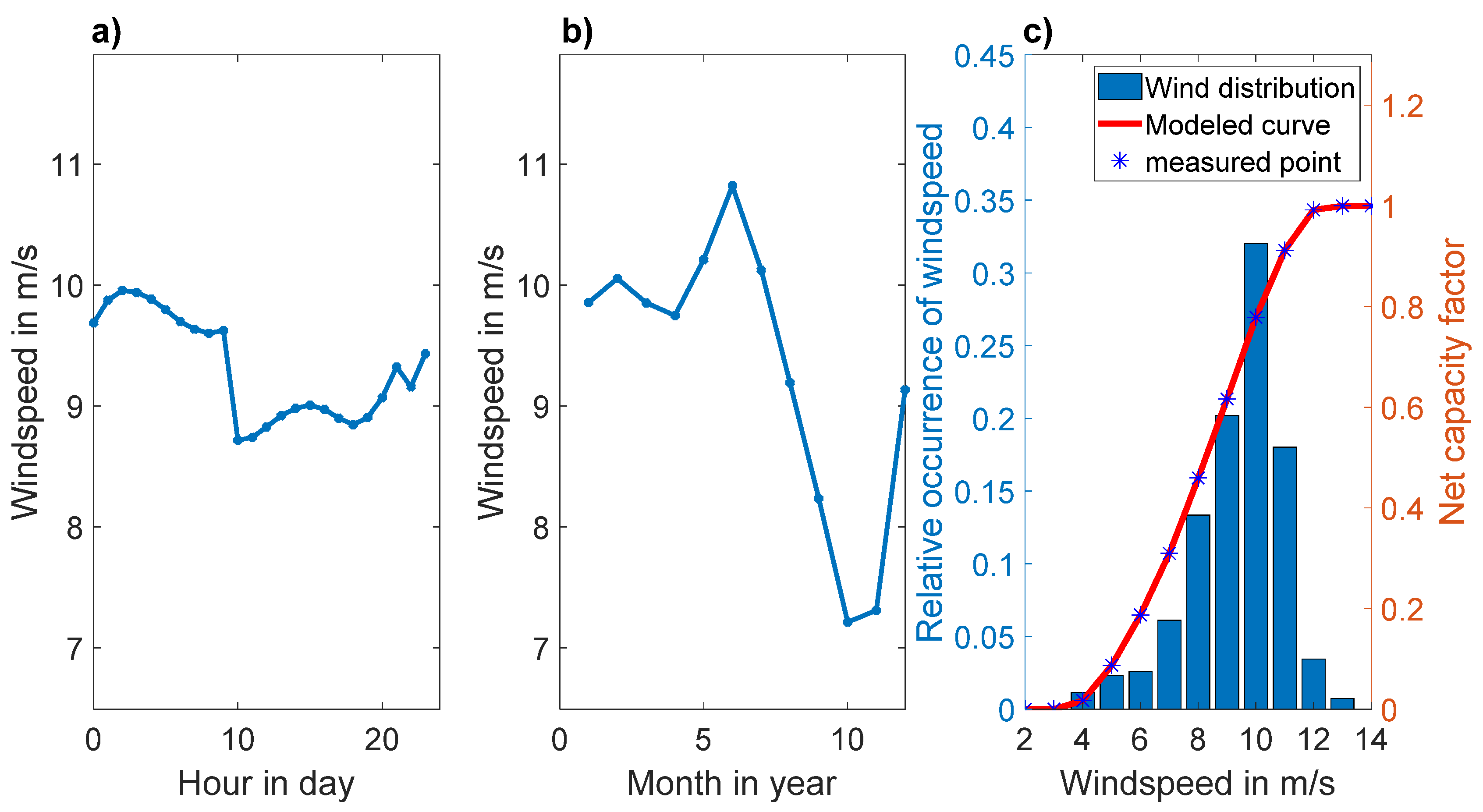
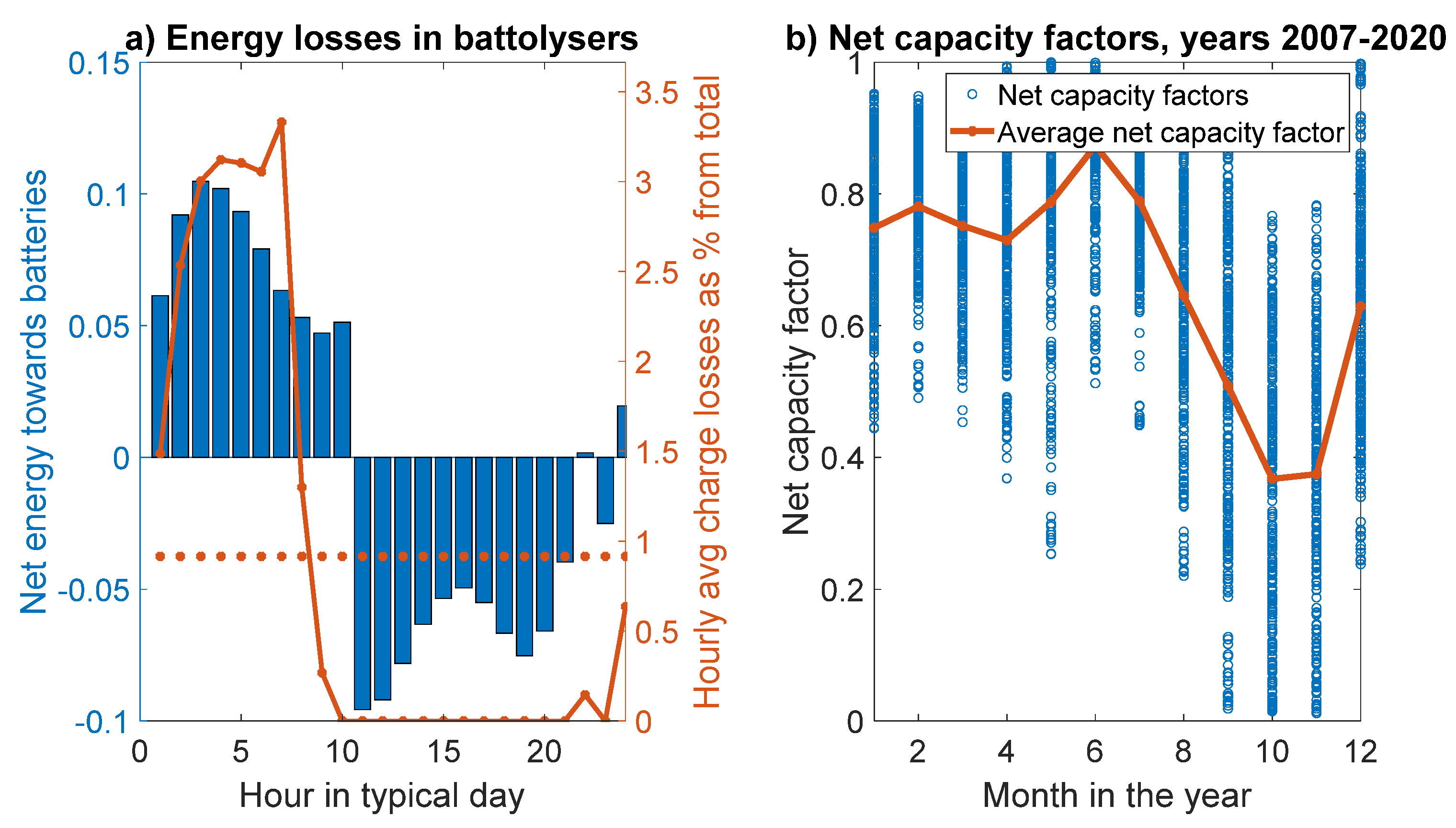
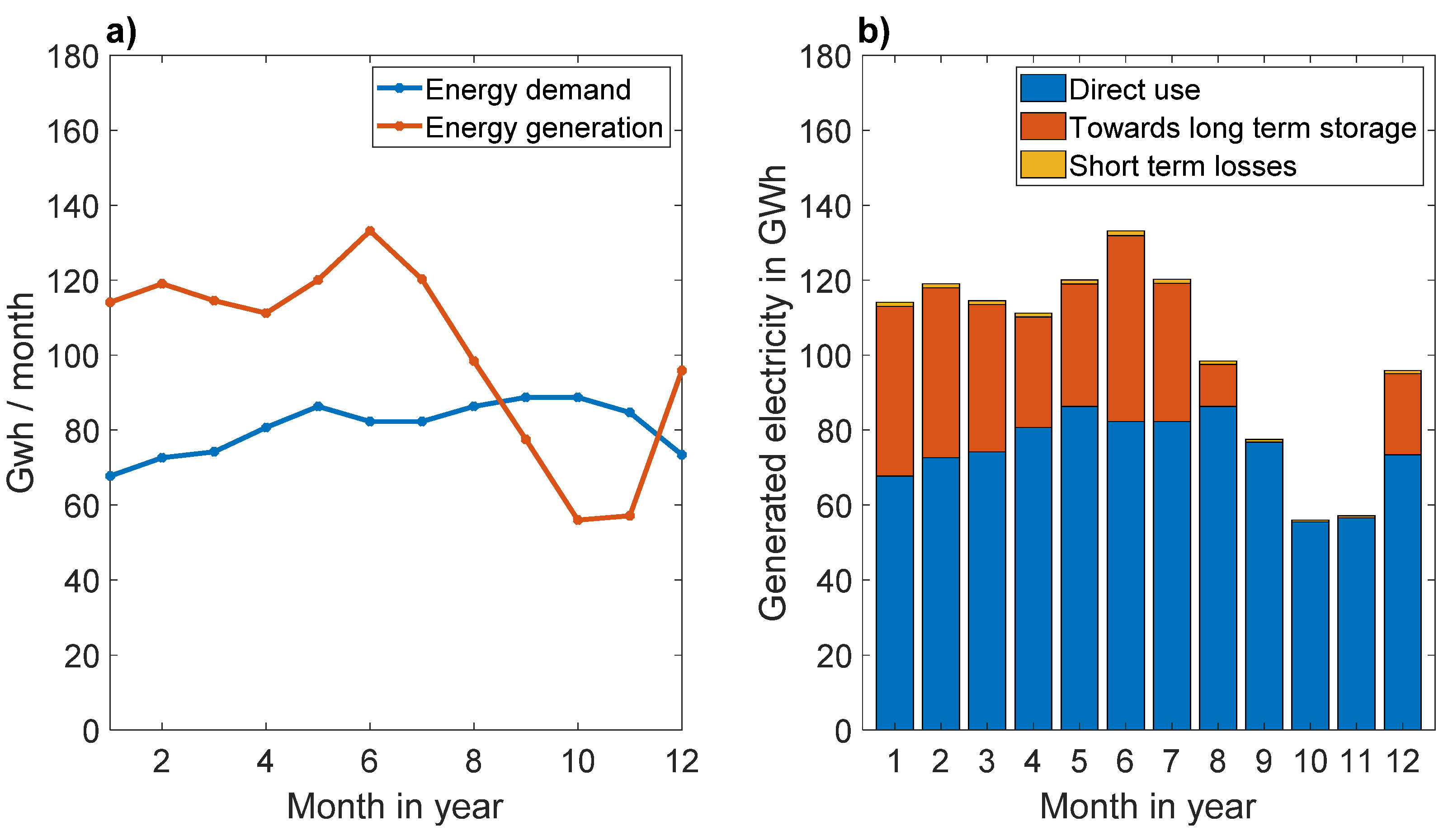


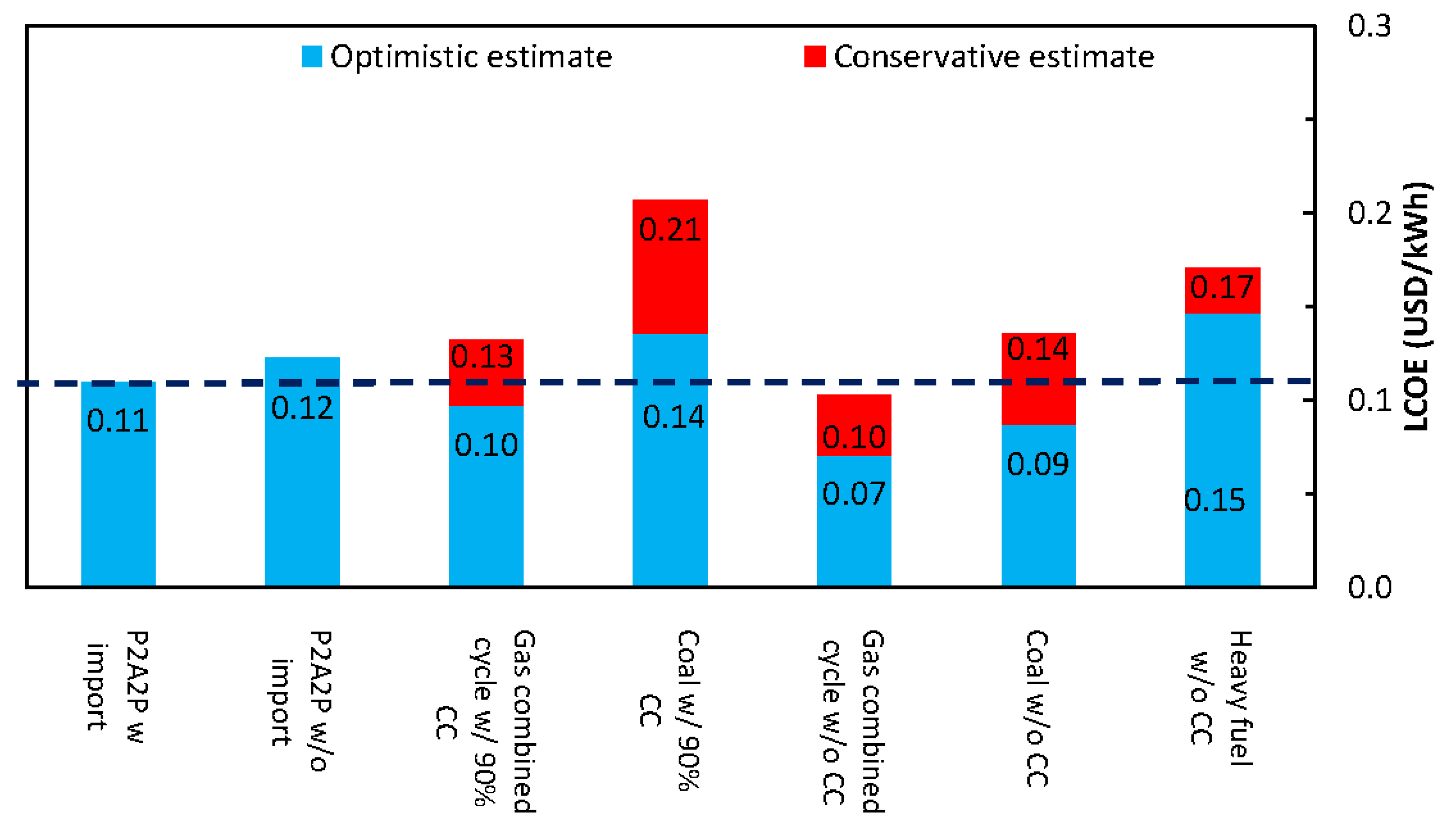
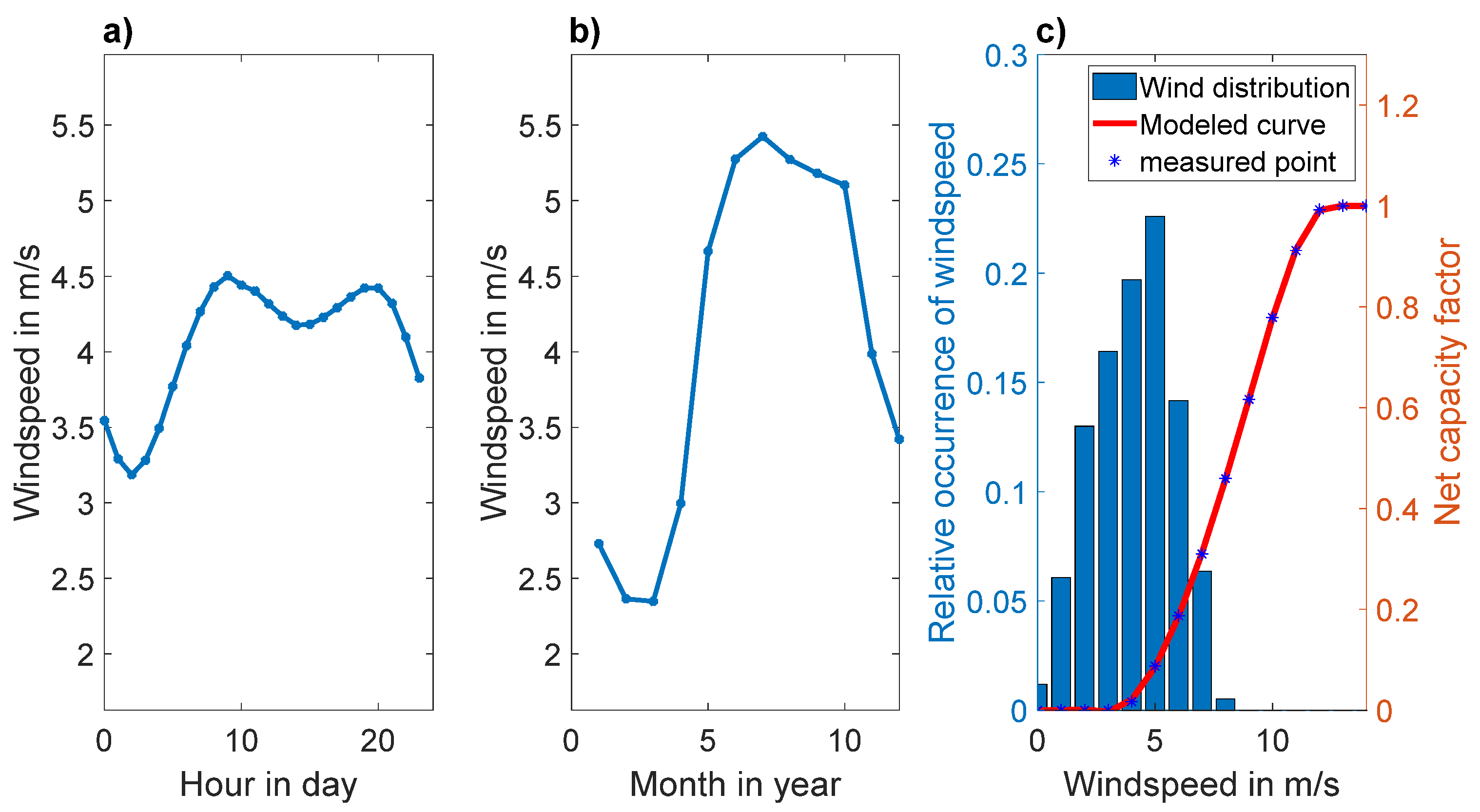





| Calculation | Method |
|---|---|
| Wind turbine generation curves | Matlab, wind data from ERA5 database, example wind turbine from literature. |
| Demand curves | From literature, implemented in Matlab. |
| Haber–Bosch loop | Aspen Plus |
| Absorption columns in HB loop and other equipment | Matlab with property data from literature/Aspen Plus. |
| Equipment dimensions | Iterative loop in Matlab until annual shortage = annual surplus = 0. |
| Costs and sensitivity analyses | Excel, and imported to Matlab, or directly in Matlab. |
| Process | Energy in kWh/kg NH3 | Reference |
|---|---|---|
| Water desalination | 0.02 | [10,34] |
| Electrolysis | 8.75 | [47] |
| PSA | 0.35 | [48] |
| Ammonia synthesis loop | 2.76 | Absorption beds [49], rest Aspen Plus |
| Ammonia storage | 0.16 | [37,50] |
| Total | 12.0 |
| Curaçao | Viti Levu | |
|---|---|---|
| Cheapest configuration | With ammonia import | With ammonia import |
| Isolated islanded system | Economically feasible | Not economically feasible |
| Islanded system including ammonia imports | Economically feasible | Not economically feasible |
Publisher’s Note: MDPI stays neutral with regard to jurisdictional claims in published maps and institutional affiliations. |
© 2022 by the authors. Licensee MDPI, Basel, Switzerland. This article is an open access article distributed under the terms and conditions of the Creative Commons Attribution (CC BY) license (https://creativecommons.org/licenses/by/4.0/).
Share and Cite
Sagel, V.N.; Rouwenhorst, K.H.R.; Faria, J.A. Renewable Electricity Generation in Small Island Developing States: The Effect of Importing Ammonia. Energies 2022, 15, 3374. https://doi.org/10.3390/en15093374
Sagel VN, Rouwenhorst KHR, Faria JA. Renewable Electricity Generation in Small Island Developing States: The Effect of Importing Ammonia. Energies. 2022; 15(9):3374. https://doi.org/10.3390/en15093374
Chicago/Turabian StyleSagel, Victor N., Kevin H. R. Rouwenhorst, and Jimmy A. Faria. 2022. "Renewable Electricity Generation in Small Island Developing States: The Effect of Importing Ammonia" Energies 15, no. 9: 3374. https://doi.org/10.3390/en15093374
APA StyleSagel, V. N., Rouwenhorst, K. H. R., & Faria, J. A. (2022). Renewable Electricity Generation in Small Island Developing States: The Effect of Importing Ammonia. Energies, 15(9), 3374. https://doi.org/10.3390/en15093374








